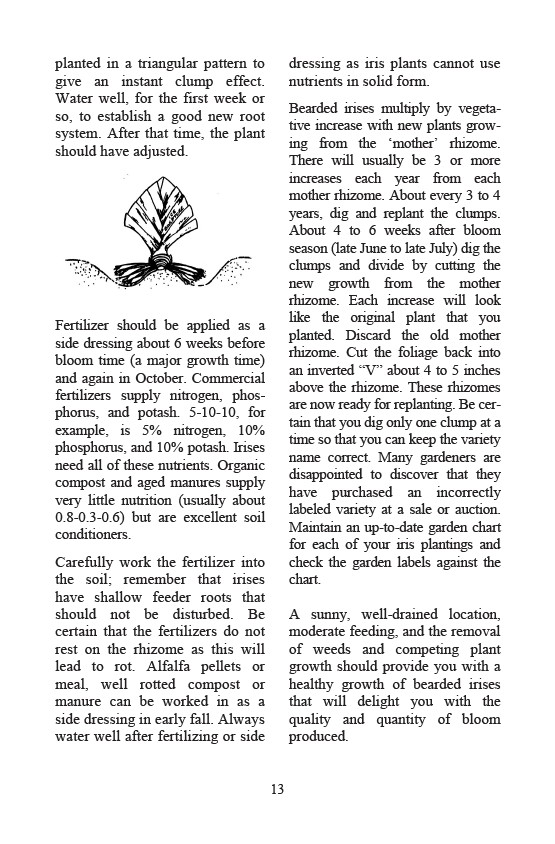
13
planted in a triangular pattern to
give an instant clump effect.
Water well, for the first week or
so, to establish a good new root
system. After that time, the plant
should have adjusted.
Fertilizer should be applied as a
side dressing about 6 weeks before
bloom time (a major growth time)
and again in October. Commercial
fertilizers supply nitrogen, phos-phorus,
and potash. 5-10-10, for
example, is 5% nitrogen, 10%
phosphorus, and 10% potash. Irises
need all of these nutrients. Organic
compost and aged manures supply
very little nutrition (usually about
0.8-0.3-0.6) but are excellent soil
conditioners.
Carefully work the fertilizer into
the soil; remember that irises
have shallow feeder roots that
should not be disturbed. Be
certain that the fertilizers do not
rest on the rhizome as this will
lead to rot. Alfalfa pellets or
meal, well rotted compost or
manure can be worked in as a
side dressing in early fall. Always
water well after fertilizing or side
dressing as iris plants cannot use
nutrients in solid form.
Bearded irises multiply by vegeta-tive
increase with new plants grow-ing
from the „mother‟ rhizome.
There will usually be 3 or more
increases each year from each
mother rhizome. About every 3 to 4
years, dig and replant the clumps.
About 4 to 6 weeks after bloom
season (late June to late July) dig the
clumps and divide by cutting the
new growth from the mother
rhizome. Each increase will look
like the original plant that you
planted. Discard the old mother
rhizome. Cut the foliage back into
an inverted “V” about 4 to 5 inches
above the rhizome. These rhizomes
are now ready for replanting. Be cer-tain
that you dig only one clump at a
time so that you can keep the variety
name correct. Many gardeners are
disappointed to discover that they
have purchased an incorrectly
labeled variety at a sale or auction.
Maintain an up-to-date garden chart
for each of your iris plantings and
check the garden labels against the
chart.
A sunny, well-drained location,
moderate feeding, and the removal
of weeds and competing plant
growth should provide you with a
healthy growth of bearded irises
that will delight you with the
quality and quantity of bloom
produced.